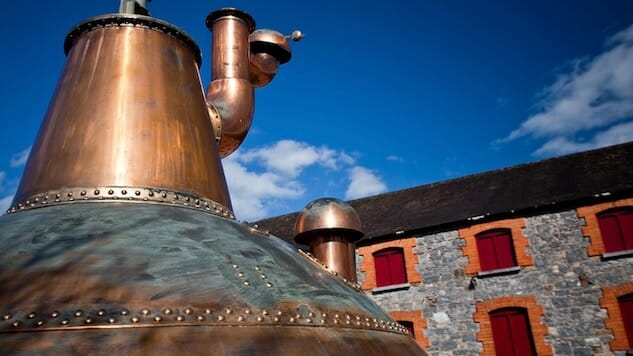Everything You Need to Know About Single Pot Still Whiskey
Photo via Shutterstock/Arvydas Kniuksta
Across the Atlantic, Irish Whiskey has become resurgent almost in tandem with “America’s Bourbon Boom,” and the resurgence has been driven in large part by Americans desire to drink the stuff too. Following its nadir in the 1970s global whiskey crash, which saw the Irish whiskey industry contract down to just two working distilleries (one of those in Northern Ireland), Irish Whiskey survived and is now thriving. In terms of premium Irish Whiskey, the thing generating the most buzz is the rebound of single pot still whiskey.
Single pot still is like single malt, in that it comes from a single distillery, is made in a pot still and with barley. The difference is that, whereas single malts are made from 100% malted barley, single pot still whiskey is made with both malted and unmalted (green) barley. All current single pot stills are also triple distilled, although there is no requirement that they be made this way. This use of green barley gives the whiskey a spicier flavor and a thicker texture.
The origin of single pot still whiskey is found in the Irish disdain for British taxes. A few years after losing the American Revolutionary War, the British Crown decided to clamp down on tax avoidance by Irish distillers by changing the way they were taxed, and introduced a tax on malted barley (with the added bonus of taxing brewers too). The Irish were making malt whiskey, and to reduce their tax burden they started using mash bills mixing malted and unmalted barley, since the green version of the grain was still untaxed.
After the Irish whiskey industry nearly went bust in the 1970s, single pot still production continued only at New Midleton Distillery in Cork County, makers of Jameson and other brands. This was due in large part to the commitment of one man, then Master Distiller Barry Crockett. The use of pot still whiskey was a distinctive mark in Midleton blends like Jameson and Powers, setting them apart from Bushmills.
Now other Irish distillers are taking up single pot still again. Kilbeggan reportedly made some pot still whiskey several years ago, but this has yet to appear in a single pot still expression.
Both Teeling Whiskey and Walsh Whiskey have new distilleries making pot still whiskeys, but it will be at least a couple of years before even a young release from these become available. For the time being, all single pot still brands are made using stock from New Midleton Distillery, but not necessary aged and bottled by them.
Midleton

Barry Crocket created the Midleton brand in 1984 with the launch of Midleton Very Rare, a blend chosen from well-aged stocks. Since then, the Midleton brand has been used for a succession of super premium, very old and quite pricey limited edition whiskeys, and some of these have been single pot stills. A recent example is Midleton Dair Ghaelach, a cask strength single pot still made with stock ranging from 15 to 22 years old and finished in new Irish oak casks.
-

-

-

-

-

-

-

-

-

-

-

-

-

-

-

-

-

-

-

-

-

-

-

-

-

-

-

-

-

-

-

-

-

-

-

-

-

-

-

-











































